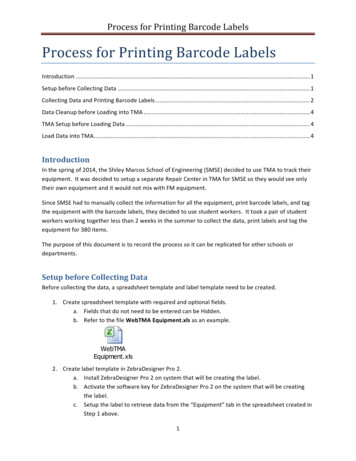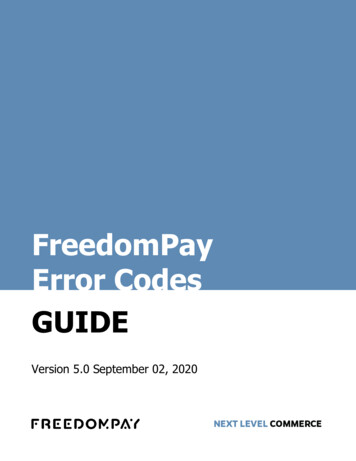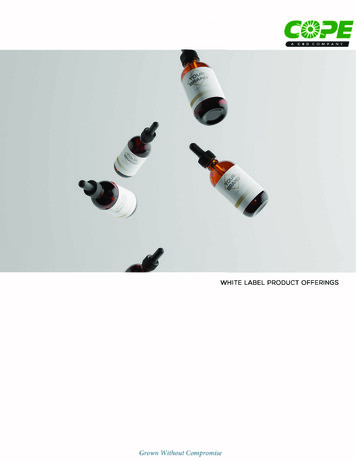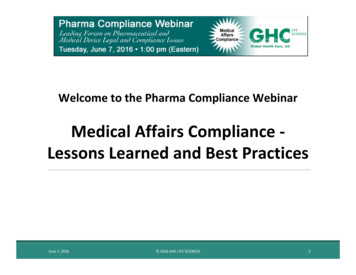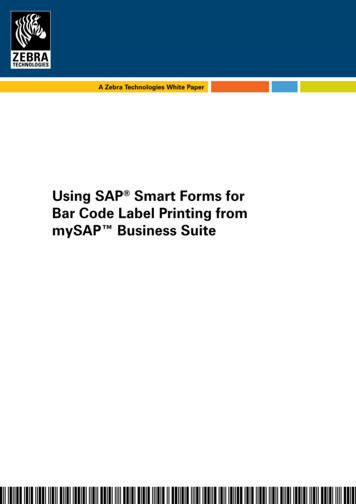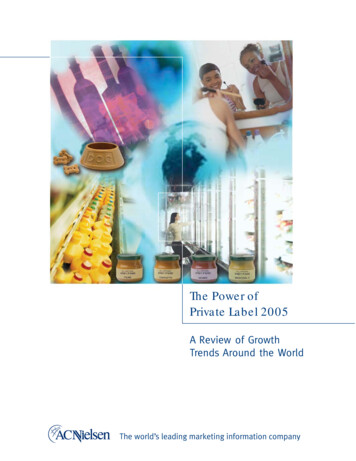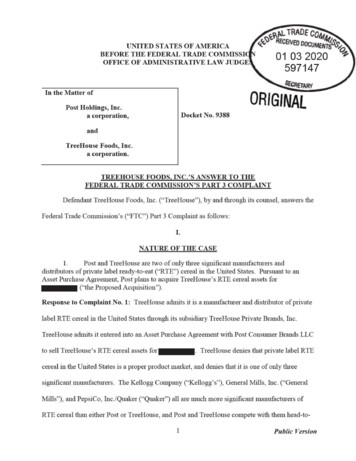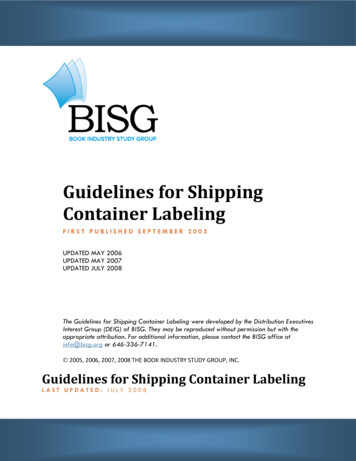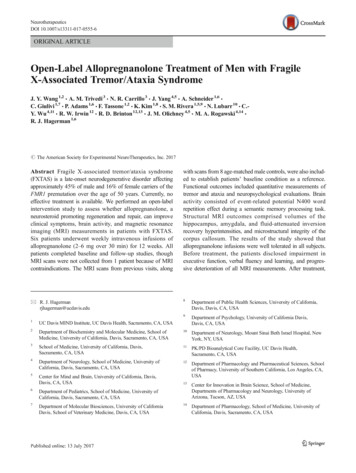
Transcription
NeurotherapeuticsDOI 10.1007/s13311-017-0555-6ORIGINAL ARTICLEOpen-Label Allopregnanolone Treatment of Men with FragileX-Associated Tremor/Ataxia SyndromeJ. Y. Wang 1,2 & A. M. Trivedi 3 & N. R. Carrillo 3 & J. Yang 4,5 & A. Schneider 1,6 &C. Giulivi 1,7 & P. Adams 1,6 & F. Tassone 1,2 & K. Kim 1,8 & S. M. Rivera 1,5,9 & N. Lubarr 10 & C.Y. Wu 4,11 & R. W. Irwin 12 & R. D. Brinton 12,13 & J. M. Olichney 4,5 & M. A. Rogawski 4,14 &R. J. Hagerman 1,6# The American Society for Experimental NeuroTherapeutics, Inc. 2017Abstract Fragile X-associated tremor/ataxia syndrome(FXTAS) is a late-onset neurodegenerative disorder affectingapproximately 45% of male and 16% of female carriers of theFMR1 premutation over the age of 50 years. Currently, noeffective treatment is available. We performed an open-labelintervention study to assess whether allopregnanolone, aneurosteroid promoting regeneration and repair, can improveclinical symptoms, brain activity, and magnetic resonanceimaging (MRI) measurements in patients with FXTAS.Six patients underwent weekly intravenous infusions ofallopregnanolone (2–6 mg over 30 min) for 12 weeks. Allpatients completed baseline and follow-up studies, thoughMRI scans were not collected from 1 patient because of MRIcontraindications. The MRI scans from previous visits, alongwith scans from 8 age-matched male controls, were also included to establish patients’ baseline condition as a reference.Functional outcomes included quantitative measurements oftremor and ataxia and neuropsychological evaluations. Brainactivity consisted of event-related potential N400 wordrepetition effect during a semantic memory processing task.Structural MRI outcomes comprised volumes of thehippocampus, amygdala, and fluid-attenuated inversionrecovery hyperintensities, and microstructural integrity of thecorpus callosum. The results of the study showed thatallopregnanolone infusions were well tolerated in all subjects.Before treatment, the patients disclosed impairment inexecutive function, verbal fluency and learning, and progressive deterioration of all MRI measurements. After treatment,* R. J. Hagermanrjhagerman@ucdavis.edu8Department of Public Health Sciences, University of California,Davis, Davis, CA, USA9Department of Psychology, University of California Davis,Davis, CA, USA1UC Davis MIND Institute, UC Davis Health, Sacramento, CA, USA2Department of Biochemistry and Molecular Medicine, School ofMedicine, University of California, Davis, Sacramento, CA, USA10Department of Neurology, Mount Sinai Beth Israel Hospital, NewYork, NY, USA3School of Medicine, University of California, Davis,Sacramento, CA, USA11PK/PD Bioanalytical Core Facility, UC Davis Health,Sacramento, CA, USA4Department of Neurology, School of Medicine, University ofCalifornia, Davis, Sacramento, CA, USA125Center for Mind and Brain, University of California, Davis,Davis, CA, USADepartment of Pharmacology and Pharmaceutical Sciences, Schoolof Pharmacy, University of Southern California, Los Angeles, CA,USA13Center for Innovation in Brain Science, School of Medicine,Departments of Pharmacology and Neurology, University ofArizona, Tucson, AZ, USA14Department of Pharmacology, School of Medicine, University ofCalifornia, Davis, Sacramento, CA, USA6Department of Pediatrics, School of Medicine, University ofCalifornia, Davis, Sacramento, CA, USA7Department of Molecular Biosciences, University of CaliforniaDavis, School of Veterinary Medicine, Davis, CA, USA
Wang et al.the patients demonstrated improvement in executive functioning, episodic memory and learning, and increased N400 repetition effect amplitude. Although MRI changes were not significant as a group, both improved and deteriorated MRI measurements occurred in individual patients in contrast to uniformdeterioration before the treatment. Significant correlationsbetween baseline MRI measurements and changes in neuropsychological test scores indicated the effects of allopregnanoloneon improving executive function, learning, and memory forpatients with relatively preserved hippocampus and corpuscallosum, while reducing psychological symptoms for patientswith small hippocampi and amygdalae. The findings show thepromise of allopregnanolone in improving cognitive functioning in patients with FXTAS and in partially alleviating someaspects of neurodegeneration. Further studies are needed toverify the efficacy of allopregnanolone for treating FXTAS.Keywords Fragile X premutation . FMR1 .Neurodegeneration . Allopregnanolone . FXTAS .Neurogenesisthat allopregnanolone, by potentiating γ-aminobutryic acid Areceptor signaling, eliminates the abnormal bursting in thepremutation neurons, providing a mechanism for neuroprotection [16].Allopregnanolone is endogenously present in the peripheryand brain, and thus is expected to be safe for long-term treatment. Intravenous infusion of allopregnanolone in healthysubjects [17] and in the treatment of status epilepticus [18,19] has not revealed treatment-related adverse effects otherthan sedation and mild nausea. Given the neuroregenerativeproperties of allopregnanolone and the preclinical evidence ofefficacy in the FXTAS model, we sought to conduct a preliminary, open-label investigation of the therapeutic potential ofallopregnanolone for carriers of the premutation with FXTAS.We assessed the impact of allopregnanolone on workingmemory deficits and neurological symptoms. In addition, weexplored whether improvements in mitochondrial functionand magnetic resonance imaging (MRI) measurements canbe observed that reflect neuroregeneration and alleviation ofwhite matter disease.IntroductionMethodsFragile X-associated tremor/ataxia syndrome (FXTAS) is alate-adult–onset neurodegenerative disorder that affects, withage- and sex-specific penetrance, carriers of premutation alleles (55–200 CGG repeats) of the fragile X mental retardation1 (FMR1) gene. Defining clinical features of FXTAS includeprogressive kinetic tremor, gait ataxia, executive function andmemory deficits, peripheral neuropathy, and parkinsonism.Associated variable features include cognitive impairmentand dementia; psychiatric symptoms, such as depression;and dysautonomia [1–4]. FXTAS is characterized by progressive global brain atrophy and white matter disease of both thecerebellum and cerebrum [5–8]. Cerebellar and brainstem atrophy and ventricular enlargement are detectable even beforethe onset of tremor or ataxia [6, 9, 10]. Currently, no specifictreatment for FXTAS can slow the progression of neurodegeneration, though symptomatic treatments exist for some of thesymptoms, such as tremor [11].Allopregnanolone is a naturally occurring neurosteroidwith activity as a positive modulator of γ-aminobutryic acidA receptors that can stimulate hippocampal neurogenesis andreverse hippocampal-dependent learning and memory dysfunction [12]. Allopregnanolone also promotesoligodendrogenesis and myelination [13] and confers neuroprotection by reducing the expression of the proapoptotic protein caspase 3 [14, 15]. We recently reported that hippocampalneurons cultured from premutation mice exhibit abnormal network bursting [16]. Such persistent bursting is a plausiblemechanism for the neurodegeneration that leads to the neurological symptoms in FXTAS. We have further demonstratedStudy Design and PatientsThis study was a preliminary, 3-month, open-label, uncontrolled trial of allopregnanolone treatment in 6 men withFXTAS who received weekly intravenous infusions for aperiod of 12 weeks. Patients with FXTAS were recruitedat the University of California, Davis (UC Davis), MINDInstitute’s Fragile X Research and Treatment Center between December 2015 and March 2016, with the last participant completing treatment in July 2016. Notification ofthe study was provided on ClinicalTrials.gov (Identifier:NCT02603926).Individuals aged 50–85 years with the premutation and adiagnosis of FXTAS were eligible for the study. Exclusioncriteria were other serious systemic disease, alcohol or drugabuse, and current use of phenytoin. To establish patients’baseline condition, we included scans acquired before thetreatment. Table 1 summarizes demographic information forthe enrollees. Serial brain MRI scans from 8 age-matchedhealthy men carrying normal FMR1 alleles (CGG repeatlength 20–32) were used as a null reference group forassessing MRI parameters (age 61 6 years, range 52–72years, 2–3 scans/individual).CGG-repeat sizing was carried out using a polymerasechain reaction-based approach [20]. Mitochondrial outcomesin lymphocytes were measured, as previously described [21].Lactate and pyruvate ratios from lymphocytes were detectedby utilizing a metabolomic approach.
Open-Label Allopregnanolone Treatment of Men with FXTASTable 1 DemographicinformationParticipantsAgeTotal no. of years)HandednessPatient 1571104516RightPatient 268388427RightPatient 3Patient 479640283105342020RightRightPatient 5Patient 66874228598351720RightRightFXTAS Fragile X-associated tremor/ataxia syndromeInterventionThe study was conducted under US Food and DrugAdministration-approved Investigational New DrugApplications 111,085 (to MAR) and 125,502 (to RJH) andwith the consent of the UC Davis Institutional ReviewBoard. Written informed consent was also obtained from eachpatient prior to the study. Allopregnanolone intravenous injection was formulated at the UC Davis Good ManufacturingPractices Laboratory and dispensed by the UC DavisInvestigational Drug Pharmacy. The formulation consistedof 99.9% pure GMP-grade allopregnanolone (3α-hydroxy5α-pregnan-20-one) at a concentration of 0.5 mg/ml in 0.9%sodium chloride injection, United States Pharmacopeia, containing 6% sulfobutyl ether-β-cyclodextrin sodium salt,United States Pharmacopeia (Dexolve; CycloLab, Budapest,Hungary). The weekly intravenous infusions and follow-upobservations were performed at the Infusion Center at theUC Davis CTSC Clinical Research Center (CCRC) exceptfor 2 patients residing in the New York area who receivedtheir first 3 infusions at the CCRC Infusion Center and theremainder of their infusions at the Mount Sinai Beth IsraelHospital Therapeutic Infusion Center (New York, NY, USA)under the supervision of one of the co-authors of this study(NL).All infusions were administered over 30 min, followed by aflush for 30 min. The dose for the first infusion was 2.0 mg;the subsequent week, the dose was increased to 4.0 mg; andfinally increased to 6.0 mg in the third week. The RichmondAgitation Sedation Scale (RASS) was administered before,during, and after each infusion. Infusions were to be terminated if the score fell below –1 (drowsy) during the infusion.Each subject had a RASS score of 0 (alert and calm) beforebeginning infusion and maintained the RASS score of 0throughout each infusion. Since the 6.0-mg dose was toleratedby all subjects, this dose was administered on weeks 3 to 12 inall cases.Each participant was required to be accompanied by achaperone, who drove the participant home from the CCRCInfusion Center and remained with the participant for at least20 h, to monitor for adverse effects.Blood Level Measurements and PharmacokineticAnalysisPlasma allopregnanolone levels were determined by liquidchromatography–tandem mass spectrometry in 1 subject inblood samples drawn at intervals during and after a 6-mginfusion from the opposite arm of that receiving the intravenous infusion. Blood was collected in heparinized tubes before infusion (0 time), at 15 and 30 min during the infusion,and at 30, 90, and 150 min after the infusion. The blood wascentrifuged at 1500 g for 10 min to separate the plasma, whichwas stored at 80 C until the time of analysis. D4allopregnanolone was added as internal standard, and theanalytes were extracted using the solid phase extraction method and injected into a Waters ACQUITY UPLC System(Waters, Milford, MA, USA). The effluent was directed to aXevo TQ-S triple quadrupole mass spectrometer, which wasused to ionize target molecules and monitor the ion m/z transitions from 319.20 283.30 for allopregnanolone quantification and 323.3 287.3 for D4-allopregnanolone quantification. Two-compartment pharmacokinetic parameters wereestimated with Phoenix WinNonlin 7.0 (Certara, Princeton,NJ, USA).Assessments and Follow-UpClinical AssessmentAll participants completed baseline and follow-up clinical examinations and neuropsychological assessments. A detailedphysical and neurological examination was performed andvideotaped [22], emphasizing the major features of FXTAS:cerebellar ataxia, intention tremor, and neuropathy findings,such as vibration sense and pinprick sensation.Neuropsychological and Emotional AssessmentLearning and memory was measured through the CaliforniaVerbal Learning Test 2 [23]. Working memory was assessedusing Weschler Memory Scale-IV (WMS-IV) [24]. Othercognitive measures included Mini Mental Status Exam
Wang et al.(MMSE) [25], Behavior Dyscontrol Scale (BDS-2) [26, 27],Cambridge Neuropsychological Test Automated Battery(CANTAB) [28], and Controlled Oral Word AssociationTest [29]. The Symptom Checklist-90-Revised (SCL-90-R)[30], and Beck Anxiety Inventory [31] were used to assessneuropsychological symptoms. In addition, CATSYS [32, 33]tremor and sway assessments evaluated improvements inhand tremor and balance. Table 2 shows a brief descriptionof functional measures used in the study.MRI Acquisitions and AnalysesMRI scans were acquired on a Siemens Trio 3 T MRI scanner(Siemens Medical Solutions, Erlangen, Germany) equippedwith a 32-channel head coil. High-resolution T1-weightedMagnetization Prepared Rapid Gradient Echo (MPRAGE)images were acquired in 192 sagittal slices of 1-mm thicknesswith field of view (FOV) 256 mm, 256 256 matrix, repetition time (TR) of 2170 ms, echo time (TE) of 4.82 ms, and 7 flip angle. Fluid attenuated inversion recovery (FLAIR) images for quantifying subcortical lesions were acquired in 104sagittal slices of 1.9-mm thickness with FOV 243 mm, 512 512 matrix, TR of 5000 ms, TE of 456 ms, and inversion time1700 ms. Diffusion tensor imaging (DTI) scans for assessingmicrostructural integrity were obtained using a single shotspin-echo echo planar imaging (EPI) sequence in 68 axialslices of 2-mm thickness with FOV 224 mm, 112 112 matrixzero-filled to 224 224 pixels, TR of 7100 ms, TE of 73 ms,number of excitations of 2, 30 gradient encoding directions forb 800 s/mm2, along with 4 interleaved b 0 s/mm2 images.MRI preprocessing included automated anterior commissure–posterior commissure alignment in T1-weighted scansusing acpcdetect (http://www.nitrc.org/projects/art) [34]. Forfailed cases, manual anterior commissure–posteriorTable 2commissure alignment was performed using DTI Studio(www.mristudio.org) [35]. MRI bias field correction in bothT1 and FLAIR scans were performed using N4 (http://stnava.github.io/ANTs/) [36]. For DTI scans, motion and eddy currentwere corrected using FSL (http://fsl.fmrib.ox.ac.uk/fsl/fslwiki/)[37] prior to the generation of fractional anisotropy (FA) andmean diffusivity (MD) maps using DTI Studio.Hippocampus, amygdala, and corpus callosum were segmented automatically using MRI Cloud (http://mricloud.org)[38], followed by automated machine learning-based error correction implemented in SegAdapter (https://www.nitrc.org/projects/segadapter/) [39, 40] and manual corrections. DTI FAand MD values of the corpus callosum were calculated basedon previously published method [41], with modifications.Within-subject co-registration of MD maps with T1 was performed automatically, and then manually adjusted to maximizethe match of the corpus callosum using FreeSurfer ter) [42]. Theresulting transformation was then applied to the FA maps. Tofurther reduce the effect of mismatch, we generated masks bythresholding the MD maps at 2 μm2/ms and applied the masksto both FA and MD maps using the FSL command, fslmaths.The generation of regions-of-interests for the 3 brain structures(i.e., hippocampus, amygdala, and corpus callosum), and calculation of volume, FA, and MD values were also performed inFSL using the commands fslmaths and fslstats.Segmentation of subcortical hyperintensities was performed on FLAIR scans using a fully automated tool, lesionprediction algorithm (LPA) (http://www.applied-statistics.de/lst.html) [43] from SPM12. LPA has shown high performancerelative to other publically available tools for automatedFLAIR lesion segmentation [44]. To calculate FLAIRhyperintensity volume (HV) in the corpus callosum, we applied the threshold of 0.7 to LPA-generated lesion probabilityDescription of neuropsychological and emotional testsOutcome measuresDescriptionBeck Anxiety Inventory (BAI)Behavioral Dyscontrol Scale (BDS-2)Self-report questionnaire to obtain measurement of anxietyNine-item measurements assessing frontal lobe integrity, includingexecutive function and cognitive control over behaviorsComputerized test measuring memory, attention and executive functionTest measuring postural sway, tremor, and gait using force plate andtremor penAssessment measuring verbal fluency or cognitive flexibility that canbe correlated with executive functioningAssessment measuring working memory and memory subtypesClinician-administered assessment measuring cognitive function, mentalstate, orientation, and memoryNinety-item self-reporting measure of psychological symptomsAssessment measuring immediate, delayed, visual and auditory memoryCambridge Neuropsychological Test Automated Battery (CANTAB)CATSYSControlled Oral Word Association Test (COWAT)California Verbal Learning Test (CVLT-II)Mini Mental Status Exam (MMSE)Symptom Checklist-90-Revised (SCL-90-R)Weschler Memory Scale Fourth Edition (WMS-IV)
Open-Label Allopregnanolone Treatment of Men with FXTASmaps, followed by applying corpus callosum masks usingfslmaths.Table 3 Estimated 2compartment pharmacokinetic parametersEvent-Related Potential Word Repetition Effect AssessmentElectroencephalogram (EEG) recordings were obtained during asemantic category decision/word repetition paradigm at bothvisits [45]. Categorical statements were read aloud by an experimenter, with each phrase followed ( 1 s later) by a target wordvisually presented in the center of the monitor (duration 300 ms, visual angle 0.4 ). Participants were instructed to notmove or respond for 3 s following the target word. Their response was to repeat the spoken word, followed by a Byes orBno judgment indicating whether the word was congruent withthe preceding statement (congruous trial, 50%) or not (incongruous trial, 50%). An EEG session consisted of 2 blocks of 144trials, each block lasting approximately 20 min. In each block, 12congruous category–target pairs were presented once, 12 presented twice, and 12 presented 3 times. Equal numbers of incongruous pairs were presented in the same repetition conditions.Thirty-two-channel EEG was recorded (Nicolet SM 2000amplifier, bandpass 0.016–100 Hz, sampling rate 250 Hz).Interelectrode impedance was maintained below 5 kΩ. All scalpelectrodes were referenced online to the left mastoid and rereferenced offline to the average of both mastoids. Eye movements were captured by electro-oculogram recorded with 4 electrodes (1 beneath and 1 at the outer canthus of each eye). Alltrials free of EEG/electro-oculogram artifact were averaged toproduce the event-related potential (ERP) for each participantsession.Statistical AnalysisAll statistical analyses were conducted in R 3.2.5 language andenvironment [46]. To establish baseline MRI measurements forpatients with FXTAS, group means and change rates beforetreatment were compared with the healthy controls using mixedeffects models [47]. Improvements in primary outcome measuresbefore and after treatment were tested for significance using 1sided paired t tests. Pearson correlation coefficients were utilizedto identify pretreatment MRI data predictive of functional improvements after the treatment. The threshold for statistical significance was set at .12l/h/kgCL21.87l/h/kgTmax 30 min. Cmax 35.5 ng/ml. Thefalling phase was fit to a single exponentialwith half-time of 34.7 minV volume of distribution of central compartment; V2 volume of distribution ofperipheral compartment; CL centralcompartment clearance; CL2 peripheralcompartment clearanceconcentration achieved at the end of the 30-min infusionwas 35.5 ng/ml (112 nM). The plasma concentration valuesare shown in Figure 1.Functional OutcomesAt baseline, all patients exhibited impairment in executivefunction assessed using BDS-2 (range 8–17). Four patientsshowed impairment in learning and memory (CaliforniaVerbal Learning Test-II T-score 24–37) and 4 (with 3 overlapping) disclosed compromised verbal fluency (Controlled OralWord Association Test-total raw score 16–29). In addition, 2patients showed borderline scores of WMS visual memory(73 and 79) and 1 with borderline MMSE score at 24.Table 4 shows the comparisons of functional outcome measures before and after the treatment. The majority of the patients showed improvement in mental state (MMSE), executive function (BDS-2 and CANTAB One Touch Stockings),memory (WMS-IV and CANTAB Paired AssociatesLearning), anxiety (SCL-90-R), and intention tremor(CATSYS Dot-to-Dot left-hand tremor intensity); improvement in BDS-2 and CANTAB Paired Associates Learningtotal error adjusted achieved statistical significance (p 0.009 and p 0.042, respectively).ResultsPatient 3 (body weight 76.3 kg) received an intravenous infusion of 6 mg allopregnanolone over 30 min. Blood was collected in heparinized tubes before infusion (0 time), at 15 and30 min during the infusion, and at 30, 90, and 150 min afterthe infusion. Table 3 shows the estimated 2-compartmentpharmacokinetic parameters. The peak allopregnanoloneFig. 1 Allopregnanolone plasma concentrations and pharmacokineticanalysis in patient 3
Wang et al.Table 4 Outcome measurementsbefore and after treatmentOutcome measurementsnBeforeinfusionAfterinfusionMean SDMean SD% of patientsimprovedPaired t test(1-sided)tp-valueMMSE627.3 2.328.7 0.8671.870.06BDS-2WMS-IV Auditory Memory6612.7 3.192.5 8.415.3 3.894.2 11.2100503.510.620.0090.28WMS-IV Visual Memory583.2 9.389.6 14.4801.310.13WMS-IV Immediate MemoryWMS-IV Delayed Memory5588.6 8.688.2 8.493.0 11.391.2 8.580801.43–0.670.110.73CVLT-II634.0 7.533.5 6.333–0.280.61COWAT626.2 6.726.2 4.03300.50Beck Anxiety InventorySCL-90 Global Severity Index447.0 7.455.8 14.54.5 4.151.3 7.85075–1.35–0.780.140.25CANTAB OTS PSFCCANTAB OTS MLFC (s)556.60 1.5252 24.97.17 2.1455.9 41.960602.060.420.0540.65CANTAB PAL Total Errors (Adj.)CANTAB SWM Total ErrorsCATSYS DTD TI, right hand (m/s)66676.5 44.263.8 17.20.87 0.4958.2 38.866.5 6.70.79 0.59835050–2.150.31–1.080.0420.620.16CATSYS DTD TI, left hand (m/s)CATSYS PS EO, 30 sec (mm2)Hippocampus (cm3)Amygdala (cm3)Subcortical HV (cm3)Corpus callosum (cm3)Corpus callosum HV (cm3)Corpus callosum FACorpus callosum MD (μm2/ms)6455555550.74 0.2910.1 0.815.87 1.003.13 0.3548.9 29.222.1 2.65.9 2.60.53 0.051.03 0.120.65 0.2616.0 13.65.84 1.183.14 0.3652.8 24.521.2 3.65.6 2.30.54 0.051.04 200.58N4 Repetition (μV)40.38 0.95-1.63 0.14100–4.030.014Magnetic resonance imaging measurements before infusion included only the last visits before infusion. Boldvalues indicated significance (i.e., p 0.05)MMSE Mini Mental Status Exam; BDS-2 Behavioral Dyscontrol Scale; WMS-IV Weschler Memory ScaleFourth Edition; CVLT-II California Verbal Learning Test; COWAT Controlled Oral Word Association Test;SCL-90-R Symptom Checklist-90-Revised; CANTAB Cambridge Neuropsychological Test AutomatedBattery; CANTAB OTS CANTAB One Touch Stockings; CANTAB OTS PSFC CANTAB OTS problemsolved on first choice; CANTAB OTS MLFC CANTAB OTS mean latency to first choice; CANTAB PAL CANTAB Paired Association Learning; CANTAB SWM CANTAB Spatial Working Memory; CATSYS DTDTI CATSYS Dot-to-Dot Tremor Intensity; CATSYS PS EO CATSYS Postural Sway Eyes Open; HV hyperintensity volume; FA fractional anisotropy; MD mean diffusivityMRI FindingsMRI analyses were performed on 5 patients from whom bothpre- and post-treatment MRI scans were available. Before treatment, the patients showed significant progressive atrophy in thehippocampus, amygdala, and corpus callosum; HV expansion inboth subcortical and corpus callosum regions; and FA declineand MD elevation in the corpus callosum (p from 0.001 to0.045). Compared with the controls, the patients exhibited significantly elevated corpus callosum HV and MD, as well asaccelerations in hippocampal atrophy, subcortical HVexpansion,and corpus callosum FA decline (Fig. 2). After the treatment,MRI changes in both directions were seen in individual patients(Fig. 3). However, as a group, none of the changes reachedstatistical significance at the 0.05 level (Table 4).Prediction of Cognitive ImprovementWe evaluated whether baseline MRI measurements could predictcognitive improvement after the treatment. Whereas high baseline hippocampal volume was correlated significantly with improvement in both BDS-2 and WMS-IV visual memory (r 0.89 and r 0.96, respectively; R2 0.79 and R2 0.93, respectively; p 0.043 and p 0.008, respectively), both low baseline
Subcortical HV (cm3)Amygdala (cm3)CC FAAgeamplitudes of the N400 repetition effect at POz were larger (morenegative) at the follow-up compared with the baseline (p 0.014;Table 4), suggesting beneficial intervention effects on verballearning and memory.Molecular MeasurementsNone of the mitochondrial outcomes tested (Complex I, II–III,IV, V, and citrate synthase activities; ratios of lactate-to-pyruvate,lactate, pyruvate, ratio of alanine and lactate to pyruvate; shortchain organic acids levels associated with mitochondrial respiratory chain disorders) were significantly different before and afterthe treatment (as determined by paired t test).DiscussionThis open-label study demonstrates that intravenous infusionof allopregnanolone at doses up to 6 mg are well tolerated andBefore AfterPA1PA2CC (cm3)Amygdala (cm3)Before AfterPA3PA4PA5Before AfterCC FACC Non-Lesion (cm3)Before AfterCC HV (cm3)Fig. 3 Changes in magneticresonance imaging measurementsbefore and after allopregnanolonetreatment. HV hyperintensityvolume; CC corpus callosum;FA fractional anisotropy; MD mean diffusivityHippocampus (cm3)Figure 5 shows the grand averaged ERP difference waveforms(Incongruous New minus Incongruous Old) for the baseline andfollow-up based on 4 patients. At the posterior electrodes illustrated, ERPs at the follow-up visits were more negative in generalthan those at the baseline. Paired t tests demonstrated that meanAgeBefore AfterPA12/ms)ERP ResultsAgeSubcortical HV (cm3)hippocampal and amygdala volumes were correlated significantly with reduced SCL-90-R symptom severity (r 0.98 and r 0.95, respectively; R2 0.95 and R2 0.91, respectively; p 0.023 and p 0.046, respectively). In addition, low baseline subcortical HV volume was correlated with improvement in WMSIV immediate memory (r –0.94, R2 0.88, p 0.018), andboth low baseline corpus callosum HV fraction (i.e., HV/volume) and MD values showed correlations with reduction inCANTAB One Touch Stockings mean latency to first choice(r 1.00 and r 0.99, respectively; R2 1.00 and R2 0.97, respectively; p 0.001 and p 0.013, respectively) (Fig. 4).AgeAge2/ms)AgeCC (cm3)Fig. 2 Spaghetti plots showinglongitudinal changes in magneticresonance imaging measurementsfor premutation carriers beforetreatment and controls. Orangedenotes patients with Fragile Xassociated tremor/ataxia syndrome; blue indicates controls.HV hyperintensity volume;CC corpus callosum; FA fractional anisotropy; MD meandiffusivityHippocampus (cm3)Open-Label Allopregnanolone Treatment of Men with FXTASPA2PA3PA4PA5Before AfterBefore AfterBefore After
r 0.94,R2 0.88HV (cm3)r 1.00,R2 1.00CC HV Fraction (%)Δ SCL-90-Rr 0.95,R2 0.91Amygdala (cm3)Hippocampus (cm3)Δ OTS MLFC (sec)Δ Immediate MemoryHippocampus (cm 3)r 0.89,R2 0.79Δ OTS MLFC (sec)r 0.96,R2 0.93Δ BDS-2Δ Visual MemoryWang et al.r 0.99,R2 0.972/ms)Fig. 4 Correlations between baseline magnetic resonance imagingmeasurements and changes in cognitive outcomes before and afterallopregnanolone treatment. Both correlation of coefficient (r) andcoefficient of determination of goodness of fit (R2) are provided.Shaded areas represent the 95% confidence intervals on the linearregression lines. BDS-2 Behavioral Dyscontrol Scale; SCL-90-R Symptom Checklist-90-Revised; HV hyperintensity volume; OTSMLFC Cambridge Neuropsychological Test Automated Battery OneTouch Stocking mean latency to first choice; CC corpus callosum;MD mean diffusivitywithout apparent adverse effects in men with FXTAS. In aprevious study of healthy women, a similar dose ofallopregnanolone was associated with sedation and, in somesubjects, mild nausea [17]; changes in saccadic eye movements were also consistent with sedation. While the peak concentration of allopregnanolone in patient 3 was modestlyhigher than achieved in this prior study, our subject did notexhibit sedation or nausea. The half-life of allopregnanolonefollowing termination of the infusion was approximately35 min. Therefore, the peak level was only present for a briefperiod of time, thus likely limiting the occurrence of sideeffects. In contrast, in the prior study, subjects were dosed with3 successive boluses so that levels were elevated over a moreprolonged time, increasing the likelihood that side effectswould be perceived.To date, no treatment has been demonstrated to
California, Davis, Sacramento, CA, USA 5 Center for Mind and Brain, University of California, Davis, Davis, CA, USA . Institute's Fragile X Research and Treatment Center be-tween December 2015 and March 2016, with the last par- . and Beck Anxiety Inventory [31] were used to assess ] .
